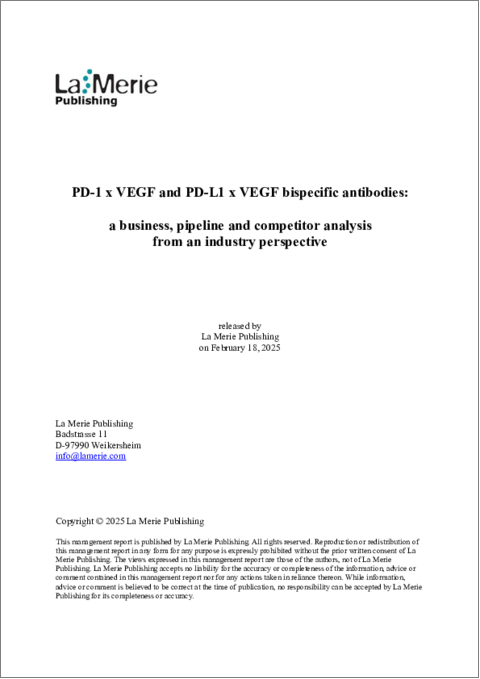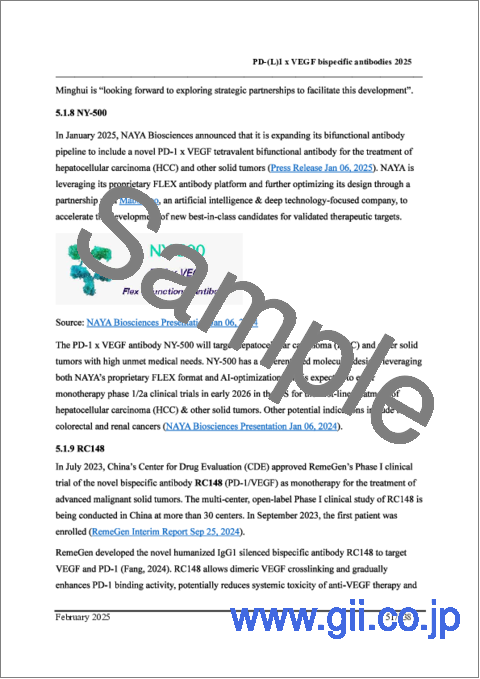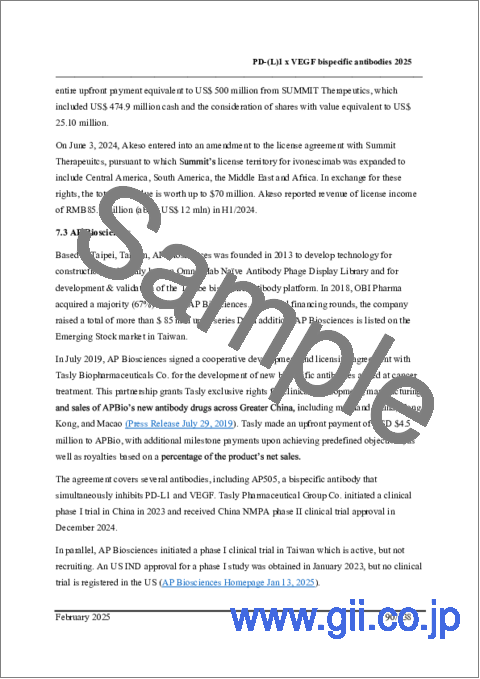|
|
市場調査レポート
商品コード
1660107
PD-1 x VEGF/PD-L1 x VEGF二重特異性抗体:業界の視点からのビジネス、パイプライン、競合の分析PD-1 x VEGF and PD-L1 x VEGF Bispecific Antibodies: A Business, Pipeline and Competitor Analysis from an Industry Perspective |
||||||
|
|||||||
| PD-1 x VEGF/PD-L1 x VEGF二重特異性抗体:業界の視点からのビジネス、パイプライン、競合の分析 |
|
出版日: 2025年02月18日
発行: La Merie Publishing
ページ情報: 英文 138 Pages
納期: 即納可能
|
全表示
- 概要
- 目次
ファーストインクラスであり、今のところベストインクラスであるPD-1xVEGF二重特異性抗体、Ivonescimabは、抗PD-1 Pembrolizumab(Keytruda)と比較して優れた臨床プロファイルと、ライセンシング契約の経済的条件により、パイプラインにおける競合の基準を設定しました。PD-1とVEGF(「協調性」)を1つの分子で同時に阻害することにより、抗PD-(L)1療法と抗VEGF療法を別々に併用する場合と比較して、安全性プロファイルが改善され、抗腫瘍活性が増強される可能性があります。第三の特異性を持つ次世代の三特異性PD-(L)xVEGF抗体は、臨床的利益をさらに向上させる可能性があります。パイプラインにあるPD-(L)1xVEGF抗体開発候補のほぼ全ては、中国での開発に重点を置く中国のバイオテクノロジー企業から生まれています。このことは、欧米のバイオ医薬品企業にとって、世界的な開発とマーケティングにおける戦略的提携の機会を提供するものです。
当レポートでは、PD-1 x VEGF/PD-L1 x VEGF二重特異性抗体について調査分析し、ステークホルダー、研究開発パイプライン、臨床プロファイル、新薬候補の分子構造、ビジネス取引に関する2025年2月現在の業界情勢を解説および分析しています。
レポートで取り上げる企業
|
|
目次
製品の説明
頻出する略語
第1章 エグゼクティブサマリー
第2章 イントロダクション
第3章 PD-(L)1xVEGF二重特異性/三重特異性パイプラインの分析
- 二重特異性PD-1xVEGF(R)抗体のパイプライン
- 二重特異性PD-L1xVEGF抗体のパイプライン
- 三重特異性PD-L1xVEGF抗体のパイプライン
第4章 PD-(L)1xVEGF二重特異性抗体の臨床経験
- PD-1xVEGF抗体
- Ivonescimab
- MHB039A
- PD-L1xVEGF抗体
- HB0025
- IMM2510
- PM8002/BNT327
第5章 PD-(L)1xVEGF(R)二重特異性抗体/三重特異性抗体の薬剤プロファイル
- PD-1xVEGF(R)二重特異性抗体の薬剤プロファイル
- AI-081
- CR-001
- Ivonescimab
- Jankistomig
- JS207
- LM-299
- MHB0039A
- NY-500
- RC148
- SCTB14
- SSGJ-707
- PD-L1xVEGF二重特異性抗体の薬剤プロファイル
- AP505、B1962
- BB-203
- HB0025
- IMM2510、SYN-2510
- PM8002、BNT327
- SG1408
- PD-(L1)xVEGF三重特異性抗体の薬剤プロファイル
- CS2009
- DR30206
- GB268
- HC010
- OGB2350
第6章 競合とステークホルダーの分析
- 先進の開発におけるPD-(L)1xVEGF抗体のステークホルダー
- 早期臨床開発におけるPD-(L)1xVEGF抗体のステークホルダー
- 非臨床研究開発におけるPD-(L)1xVEGF(R)抗体のステークホルダー
第7章 PD-(L)1xVEGF抗体を扱う企業のプロファイル
- 3SBio
- Akeso Biopharma
- AP Biosciences
- BioNTech
- Biotheus
- Bright Biologics
- Crescent Biopharma
- CStone Pharmaceuticals
- Genor Biopharma
- Hanzhou Sumgen Biotech
- HC Biopharma
- ImmuneOnco Biopharmaceuticals
- Instil Bio
- LaNova Medicines
- Merck & Co
- Minghui Pharmaceutical Co.
- NAYA Biosciences
- OncoC4
- OneGen Biotechnology
- Ottimo Pharma
- RemeGen
- Shanghai Huaota Biopharmaceutical
- Shanghai Junshi Biosciences
- SinoCellTech Group
- Summit Therapeutics
- Tasly Pharmaceutical
- Zhejiang Doer Biopharma
第8章 PD-1/PD-L1免疫腫瘍抗体市場
- 市場の概要
- PD-1抗体市場
- PD-L1抗体市場
- 二重特異性PD-1xCTLA-4・PD-1xLAG-3抗体市場
- 販売情報のないその他のPD-(L1)抗体
第9章 ビジネス取引:スピンオフ、資金調達、ライセンシング、合併・買収、バリュエーション
- スピンオフ
- ライセンシング
- 合併・買収
- バリュエーション
第10章 参考文献
This report provides you with a landscape description and analysis of PD-1 x VEGF and PD-L1 x VEGF bispecific antibodies regarding stakeholders, R&D pipeline, clinical profile and molecular structure of drug candidates and business deals from an industry perspective as of February 2025. The first-in-class and so far best-in-class PD-1xVEGF bispecific antibody ivonescimab has set the bar for competitors in the pipeline for a superior clinical profile compared with anti-PD-1 pembrolizumab (Keytruda) and for economic terms of the licensing agreement. The simultaneous blockade of PD-1 and VEGF ("cooperativity") by one molecule may produce enhanced antitumor activity with an improved safety profile compared with the co-administration of separate anti-PD-(L)1 and anti-VEGF therapies. A next generation of trispecific PD-(L)xVEGF antibodies with a third specificity may even further improve the clinical benefit. Nearly all of the PD-(L)1xVEGF antibody development candidates in the pipeline originate from Chinese biotechnology companies with focus on development in China. This provides an opportunity for Western biopharmaceutical companies for strategic collaborations in global development and marketing.
The report brings you up-to-date with information about and analysis of:
- R&D pipeline of bispecific and trispecific PD-1xVEGF(R) and PD-L1xVEGF antibodies;
- Molecular structure of PD-(L)1xVEGF(R) antibodies in development;
- Preclinical and clinical profile of PD-(L)1xVEGF(R) antibodies;
- Cancer indications in early development and in global development;
- Clinical experience with PD-(L)1xVEGF antibodies;
- Background profile of stakeholders (originator and licensee companies);
- Competitor analysis;
- Established market size for PD-1 and PD-L1 checkpoint inhibitor antibodies;
- Business deals with economic terms: spin-offs, financing, licensing; mergers & acquisitions, company valuation.
In preclinical studies, anti-vascular endothelial growth factor (VEGF) and anti-PD-(L)1 antibodies were found to have synergistic antitumor activity. Anti-VEGF not only inhibits angiogenesis but also increases immune effector cell trafficking and infiltration into the tumor microenvironment, allowing for an immuno-responsive environment, which leads to enhanced efficacy of anti-PD-(L)1 inhibitors. Combining anti-PD-(L)1 antibodies with antiangiogenic agents was found to have antitumor activity and tolerable safety in advanced solid tumors. Clinical studies have shown that the combination of PD-(L)1 and VEGF antibodies significantly improves clinical benefit over PD-(L)1 antibody alone in certain settings.
To combine both targeting approaches, bispecific antibodies targeting PD-1 and VEGF by one molecule have been designed and preclinical studies showed that the combination in one molecule was superior to the combination of two separate molecules in antitumor activity.
As PD-1 and VEGF co-express in the tumor microenvironment, the dual-target design of a bispecific antibody combines PD-1 and VEGF to enable the enrichment and retention of macromolecular drugs in the tumor microenvironment, leading to a reduced distribution in the peripheral blood and a decreased toxicity caused by off-target effects.
Methodology:
This report evaluates the industry landscape of PD-1xVEGF(R) and PD-L1xVEGF bispecific and trispecific antibodies in research and development. The report provides a comprehensive overview of the R&D and partnering activities of pharmaceutical and technology companies in the field of PD-(L)1xVEGF(R) antibodies. This report is based on the identification and description of corporate stakeholders including biopharmaceutical companies and biotechnology companies. All publicly available information is fully referenced, either with scientific references (abstracts, posters, presentations, full paper) or hyperlinks leading to the source of information, such as press releases, corporate presentations, annual reports, SEC disclosures and homepage content.
Who will benefit from the report?
- Business development and licensing (BDL) specialists;
- Venture capital, private equity and investment managers;
- Managers of Big Pharma venture capital firms;
- Financial analysts;
- CEO, COO and managing directors;
- Corporate strategy analysts and managers;
- Chief Technology Officer;
- R&D Portfolio, Technology and Strategy Management;
- Clinical and preclinical development specialists.
Companies Mentioned in the Report:
|
|
Table of Contents
Product Description
Table of Contents
Frequent Abbreviations
1. Executive Summary
2. Introduction
3. Analysis of PD-(L)1xVEGF bispecific and trispecific pipeline
- 3.1. Pipeline of bispecific PD-1xVEGF(R) antibodies
- 3.2. Pipeline of bispecific PD-L1xVEGF antibodies
- 3.3. Pipeline of trispecific PD-L1xVEGF antibodies
4. Clinical Experience with PD-(L)1xVEGF Bispecific Antibodies
- 4.1. PD-1xVEGF Antibodies
- 4.1.1. Ivonescimab
- 4.1.2. MHB039A
- 4.2. PD-L1xVEGF Antibodies
- 4.2.1. HB0025
- 4.2.2. IMM2510
- 4.2.3. PM8002/BNT327
5. PD-(L)1xVEGF(R) Bi- and Trispecific Antibody Drug Profiles
- 5.1. PD-1xVEGF(R) Bispecific Antibody Drug Profiles
- 5.1.1. AI-081
- 5.1.2. CR-001
- 5.1.3. Ivonescimab
- 5.1.4. Jankistomig
- 5.1.5. JS207
- 5.1.6. LM-299
- 5.1.7. MHB0039A
- 5.1.8. NY-500
- 5.1.9. RC148
- 5.1.10. SCTB14
- 5.1.11. SSGJ-707
- 5.2. PD-L1xVEGF Bispecific Antibody Drug Profiles
- 5.2.1. AP505; B1962
- 5.2.2. BB-203
- 5.2.3. HB0025
- 5.2.4. IMM2510; SYN-2510
- 5.2.5. PM8002; BNT327
- 5.2.6. SG1408
- 5.3. PD-(L1)xVEGF Trispecific Antibody Drug Profiles
- 5.3.1. CS2009
- 5.3.2. DR30206
- 5.3.3. GB268
- 5.3.4. HC010
- 5.3.5. OGB2350
6. Competitor and Stakeholder Analysis
- 6.1. Stakeholders with PD-(L)1xVEGF antibodies in advanced development
- 6.2. Stakeholders with PD-(L)1xVEGF antibodies in early clinical development
- 6.3. Stakeholders with PD-(L)1xVEGF(R) antibodies in non-clinical R&D
7. Profiles of Companies with PD-(L)1xVEGF Antibodies
- 7.1 3SBio
- 7.2. Akeso Biopharma
- 7.3. AP Biosciences
- 7.4. BioNTech
- 7.5. Biotheus
- 7.6. Bright Biologics
- 7.7. Crescent Biopharma
- 7.8. CStone Pharmaceuticals
- 7.9. Genor Biopharma
- 7.10. Hanzhou Sumgen Biotech
- 7.11. HC Biopharma
- 7.12. ImmuneOnco Biopharmaceuticals
- 7.13. Instil Bio
- 7.14. LaNova Medicines
- 7.15. Merck & Co
- 7.16. Minghui Pharmaceutical Co.
- 7.17. NAYA Biosciences
- 7.18. OncoC4
- 7.19. OneGen Biotechnology
- 7.20. Ottimo Pharma
- 7.21. RemeGen
- 7.22. Shanghai Huaota Biopharmaceutical
- 7.23. Shanghai Junshi Biosciences
- 7.24. SinoCellTech Group
- 7.25. Summit Therapeutics
- 7.26. Tasly Pharmaceutical
- 7.27. Zhejiang Doer Biopharma
8. PD-1 and PD-L1 Immuno-Oncology Antibody Markets
- 8.1. Market Overview
- 8.2. PD-1 Antibody Market
- 8.3. PD-L1 Antibody Market
- 8.4. Bispecific PD-1xCTLA-4 and PD-1xLAG-3 Antibody Market
- 8.5. Other PD-(L1) Antibodies without Information on Sales
9. Business Deals: spin-offs, financing, licensing, mergers & acquisitions, valuations
- 9.1. Spin-offs
- 9.2. Licensing
- 9.3. Mergers & Acquisitions
- 9.4. Valuation
10. References
Tables in the Report:
- Table 1: Overview of PD-(L)1xVEGF(R) bi- and trispecific antibodies in the pipeline
- Table 2: Overview bispecific PD-1 x VEGF(R2) antibodies
- Table 3: Overview of structural features of PD-1xVEGF(R) antibodies
- Table 4: Overview bispecific PD-L1 x VEGF antibodies
- Table 5: Overview of structural features of PD-L1xVEGF antibodies
- Table 6: Overview of trispecific PD-(L)1xVEGF antibodies
- Table 7: Overview of structural features of PD-(L)1xVEGF trispecific antibodies
- Table 8: Overview of major efficacy results in clinical phase II studies of ivonescimab
- Table 9: Clinical indications of ivonescimab in phase III studies
- Table 10: Overview of clinical studies with PM8002
- Table 11: Overview of stakeholders with PD-(L)1xVEGF antibodies in advanced development
- Table 12: Overview of Stakeholders with PD-(L)1xVEGF antibodies in early clinical development
- Table 13: Overview of Stakeholders with PD-(L)1xVEGF antibodies in non-clinical R&D
- Table 14: 2023 Total Sales of PD-1 & PD-L1 Antibodies per Class
- Table 15: Sales & Growth Rates of PD-1 & PD-L1 Antibodies 2014-2023
- Table 16: 2023 Individual Sales of Monospecific PD-1 Antibodies
- Table 17: 2023 Individual Sales of Monospecific PD-L1 Antibodies
- Table 18: 2023 Individual Sales of PD-L1 Antibody Combination Regimen
- Table 19: 2023 Individual Sales of Bispecific or Combination PD-1 Antibodies
- Table 20: Approved / Marketed PD-1 & PD-L1 Antibodies without Information on Sales
- Table 21: Overview of business deals related to PD-(L)1 x VEGF(R) targeted bi- and trispecific antibody constructs
- Table 22: Terms of Licensing Deals for PD-(L)1 x VEGF bispecific antibodies






